Neurohormones: Heart Contraction, Human Diseases and Cardiac Rhythm
VerifiedAdded on 2023/04/25
|10
|1791
|98
Essay
AI Summary
This essay explores the effects of neurohormones, such as norepinephrine and epinephrine, on heart contraction, highlighting the roles of the sympathetic and parasympathetic nervous systems in regulating heart rate and contractility. It discusses how neurotransmitters bind to adrenergic receptors, influencing heart function, and examines the impact of temperature variations on heart contraction strength. The essay also details the cardiac system's control mechanisms, including the sympathetic and parasympathetic nervous systems, and their effects on heart rate and myocardial contractility. Furthermore, it explains cellular signal transduction pathways, calcium induction, and the roles of protein kinase A (PKA) and cyclic adenosine monophosphate (cAMP) in heart contraction. The essay concludes by emphasizing the heart's vital role in regulating blood flow and hormone distribution, and also touches upon the architecture of the heart and the initiation and conduction of the pacemaker impulse throughout the myocardium using two examples of human diseases.
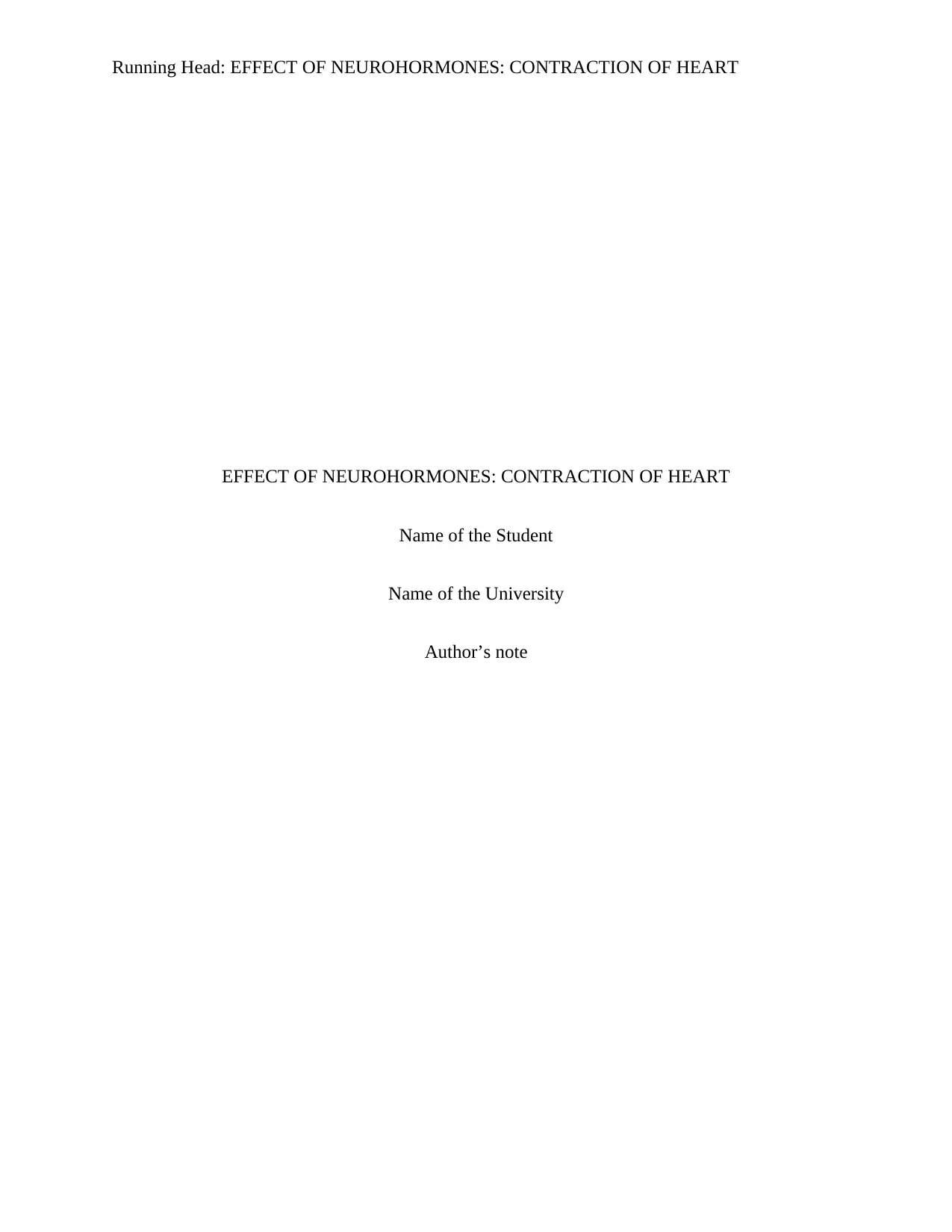
Running Head: EFFECT OF NEUROHORMONES: CONTRACTION OF HEART
EFFECT OF NEUROHORMONES: CONTRACTION OF HEART
Name of the Student
Name of the University
Author’s note
EFFECT OF NEUROHORMONES: CONTRACTION OF HEART
Name of the Student
Name of the University
Author’s note
Paraphrase This Document
Need a fresh take? Get an instant paraphrase of this document with our AI Paraphraser
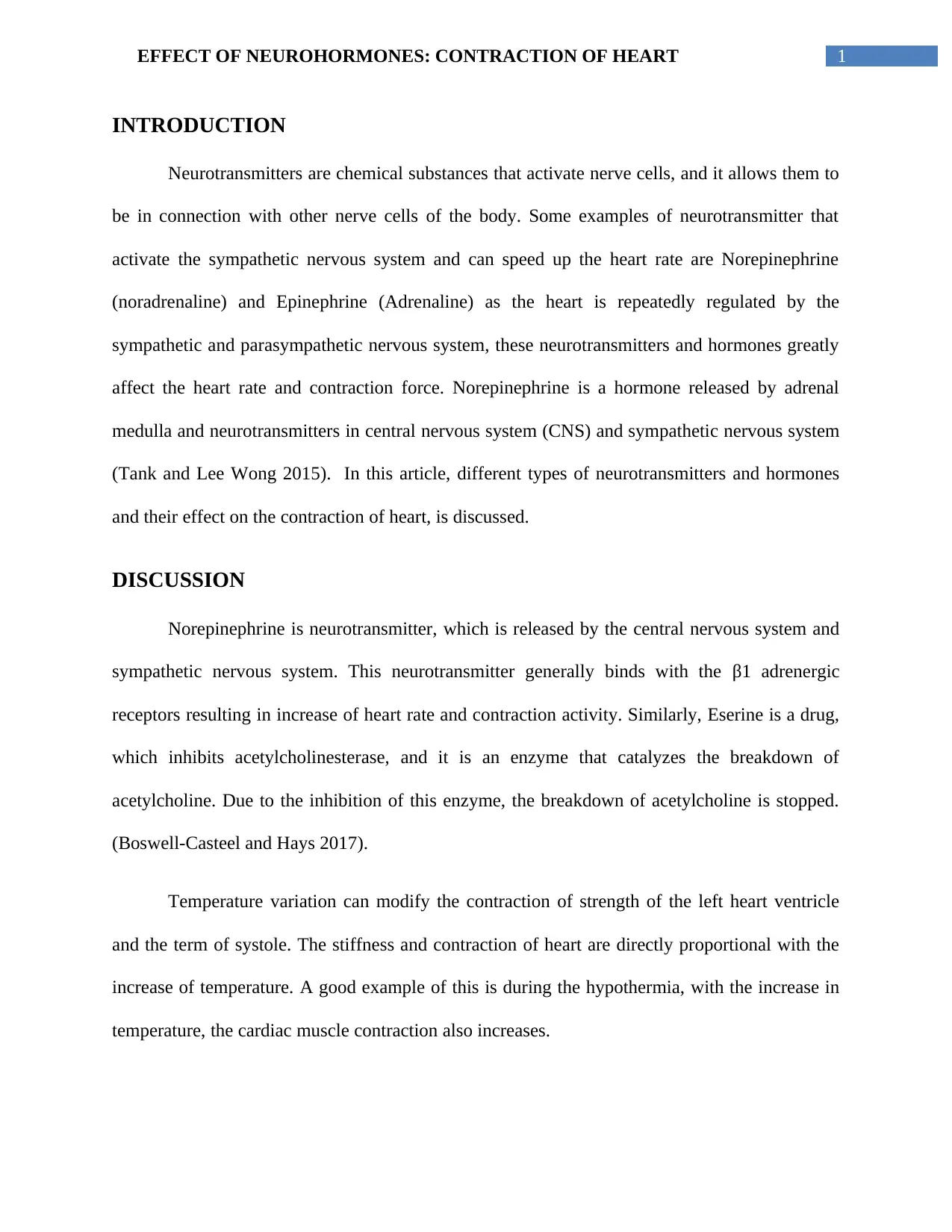
1EFFECT OF NEUROHORMONES: CONTRACTION OF HEART
INTRODUCTION
Neurotransmitters are chemical substances that activate nerve cells, and it allows them to
be in connection with other nerve cells of the body. Some examples of neurotransmitter that
activate the sympathetic nervous system and can speed up the heart rate are Norepinephrine
(noradrenaline) and Epinephrine (Adrenaline) as the heart is repeatedly regulated by the
sympathetic and parasympathetic nervous system, these neurotransmitters and hormones greatly
affect the heart rate and contraction force. Norepinephrine is a hormone released by adrenal
medulla and neurotransmitters in central nervous system (CNS) and sympathetic nervous system
(Tank and Lee Wong 2015). In this article, different types of neurotransmitters and hormones
and their effect on the contraction of heart, is discussed.
DISCUSSION
Norepinephrine is neurotransmitter, which is released by the central nervous system and
sympathetic nervous system. This neurotransmitter generally binds with the β1 adrenergic
receptors resulting in increase of heart rate and contraction activity. Similarly, Eserine is a drug,
which inhibits acetylcholinesterase, and it is an enzyme that catalyzes the breakdown of
acetylcholine. Due to the inhibition of this enzyme, the breakdown of acetylcholine is stopped.
(Boswell-Casteel and Hays 2017).
Temperature variation can modify the contraction of strength of the left heart ventricle
and the term of systole. The stiffness and contraction of heart are directly proportional with the
increase of temperature. A good example of this is during the hypothermia, with the increase in
temperature, the cardiac muscle contraction also increases.
INTRODUCTION
Neurotransmitters are chemical substances that activate nerve cells, and it allows them to
be in connection with other nerve cells of the body. Some examples of neurotransmitter that
activate the sympathetic nervous system and can speed up the heart rate are Norepinephrine
(noradrenaline) and Epinephrine (Adrenaline) as the heart is repeatedly regulated by the
sympathetic and parasympathetic nervous system, these neurotransmitters and hormones greatly
affect the heart rate and contraction force. Norepinephrine is a hormone released by adrenal
medulla and neurotransmitters in central nervous system (CNS) and sympathetic nervous system
(Tank and Lee Wong 2015). In this article, different types of neurotransmitters and hormones
and their effect on the contraction of heart, is discussed.
DISCUSSION
Norepinephrine is neurotransmitter, which is released by the central nervous system and
sympathetic nervous system. This neurotransmitter generally binds with the β1 adrenergic
receptors resulting in increase of heart rate and contraction activity. Similarly, Eserine is a drug,
which inhibits acetylcholinesterase, and it is an enzyme that catalyzes the breakdown of
acetylcholine. Due to the inhibition of this enzyme, the breakdown of acetylcholine is stopped.
(Boswell-Casteel and Hays 2017).
Temperature variation can modify the contraction of strength of the left heart ventricle
and the term of systole. The stiffness and contraction of heart are directly proportional with the
increase of temperature. A good example of this is during the hypothermia, with the increase in
temperature, the cardiac muscle contraction also increases.
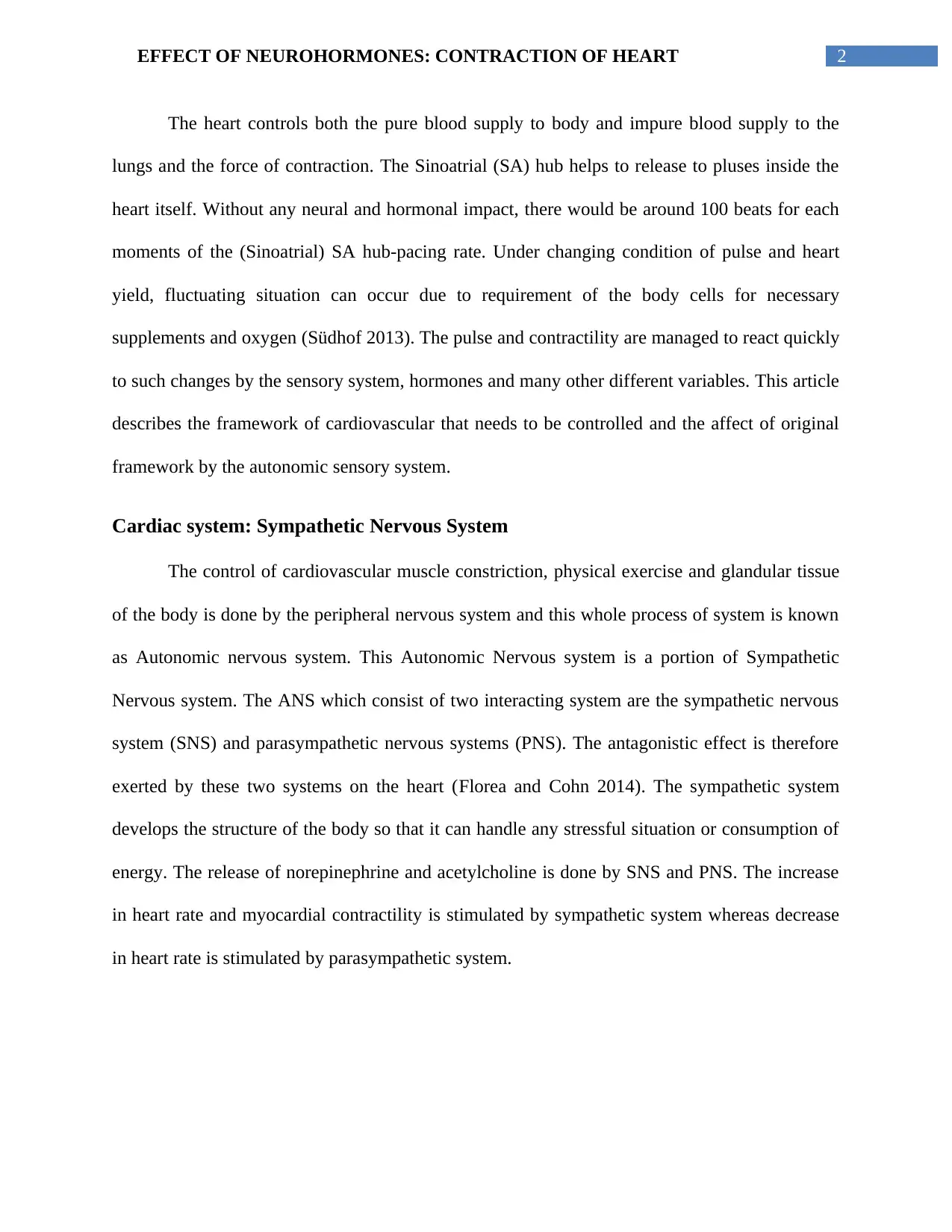
2EFFECT OF NEUROHORMONES: CONTRACTION OF HEART
The heart controls both the pure blood supply to body and impure blood supply to the
lungs and the force of contraction. The Sinoatrial (SA) hub helps to release to pluses inside the
heart itself. Without any neural and hormonal impact, there would be around 100 beats for each
moments of the (Sinoatrial) SA hub-pacing rate. Under changing condition of pulse and heart
yield, fluctuating situation can occur due to requirement of the body cells for necessary
supplements and oxygen (Südhof 2013). The pulse and contractility are managed to react quickly
to such changes by the sensory system, hormones and many other different variables. This article
describes the framework of cardiovascular that needs to be controlled and the affect of original
framework by the autonomic sensory system.
Cardiac system: Sympathetic Nervous System
The control of cardiovascular muscle constriction, physical exercise and glandular tissue
of the body is done by the peripheral nervous system and this whole process of system is known
as Autonomic nervous system. This Autonomic Nervous system is a portion of Sympathetic
Nervous system. The ANS which consist of two interacting system are the sympathetic nervous
system (SNS) and parasympathetic nervous systems (PNS). The antagonistic effect is therefore
exerted by these two systems on the heart (Florea and Cohn 2014). The sympathetic system
develops the structure of the body so that it can handle any stressful situation or consumption of
energy. The release of norepinephrine and acetylcholine is done by SNS and PNS. The increase
in heart rate and myocardial contractility is stimulated by sympathetic system whereas decrease
in heart rate is stimulated by parasympathetic system.
The heart controls both the pure blood supply to body and impure blood supply to the
lungs and the force of contraction. The Sinoatrial (SA) hub helps to release to pluses inside the
heart itself. Without any neural and hormonal impact, there would be around 100 beats for each
moments of the (Sinoatrial) SA hub-pacing rate. Under changing condition of pulse and heart
yield, fluctuating situation can occur due to requirement of the body cells for necessary
supplements and oxygen (Südhof 2013). The pulse and contractility are managed to react quickly
to such changes by the sensory system, hormones and many other different variables. This article
describes the framework of cardiovascular that needs to be controlled and the affect of original
framework by the autonomic sensory system.
Cardiac system: Sympathetic Nervous System
The control of cardiovascular muscle constriction, physical exercise and glandular tissue
of the body is done by the peripheral nervous system and this whole process of system is known
as Autonomic nervous system. This Autonomic Nervous system is a portion of Sympathetic
Nervous system. The ANS which consist of two interacting system are the sympathetic nervous
system (SNS) and parasympathetic nervous systems (PNS). The antagonistic effect is therefore
exerted by these two systems on the heart (Florea and Cohn 2014). The sympathetic system
develops the structure of the body so that it can handle any stressful situation or consumption of
energy. The release of norepinephrine and acetylcholine is done by SNS and PNS. The increase
in heart rate and myocardial contractility is stimulated by sympathetic system whereas decrease
in heart rate is stimulated by parasympathetic system.
⊘ This is a preview!⊘
Do you want full access?
Subscribe today to unlock all pages.

Trusted by 1+ million students worldwide

3EFFECT OF NEUROHORMONES: CONTRACTION OF HEART
Figure 1: Role of ANS on heart function
Source: (Gordan, Gwathmey and Xie 2015)
Control of parasympathetic nervous system and functions of heart
As mentioned above, that the effects produced by the parasympathetic system are
opposite to that of sympathetic system activation. The parasympathetic system has a little effect
on the heart contraction compared to sympathetic system. These effects are:
Negative chronotropic effect: In general, it means decrease in heartbeat, which occurs
due to the activation of vagus nerve in the sinoatrial node (Gordan, Gwathmey and Xie 2015).
Figure 1: Role of ANS on heart function
Source: (Gordan, Gwathmey and Xie 2015)
Control of parasympathetic nervous system and functions of heart
As mentioned above, that the effects produced by the parasympathetic system are
opposite to that of sympathetic system activation. The parasympathetic system has a little effect
on the heart contraction compared to sympathetic system. These effects are:
Negative chronotropic effect: In general, it means decrease in heartbeat, which occurs
due to the activation of vagus nerve in the sinoatrial node (Gordan, Gwathmey and Xie 2015).
Paraphrase This Document
Need a fresh take? Get an instant paraphrase of this document with our AI Paraphraser
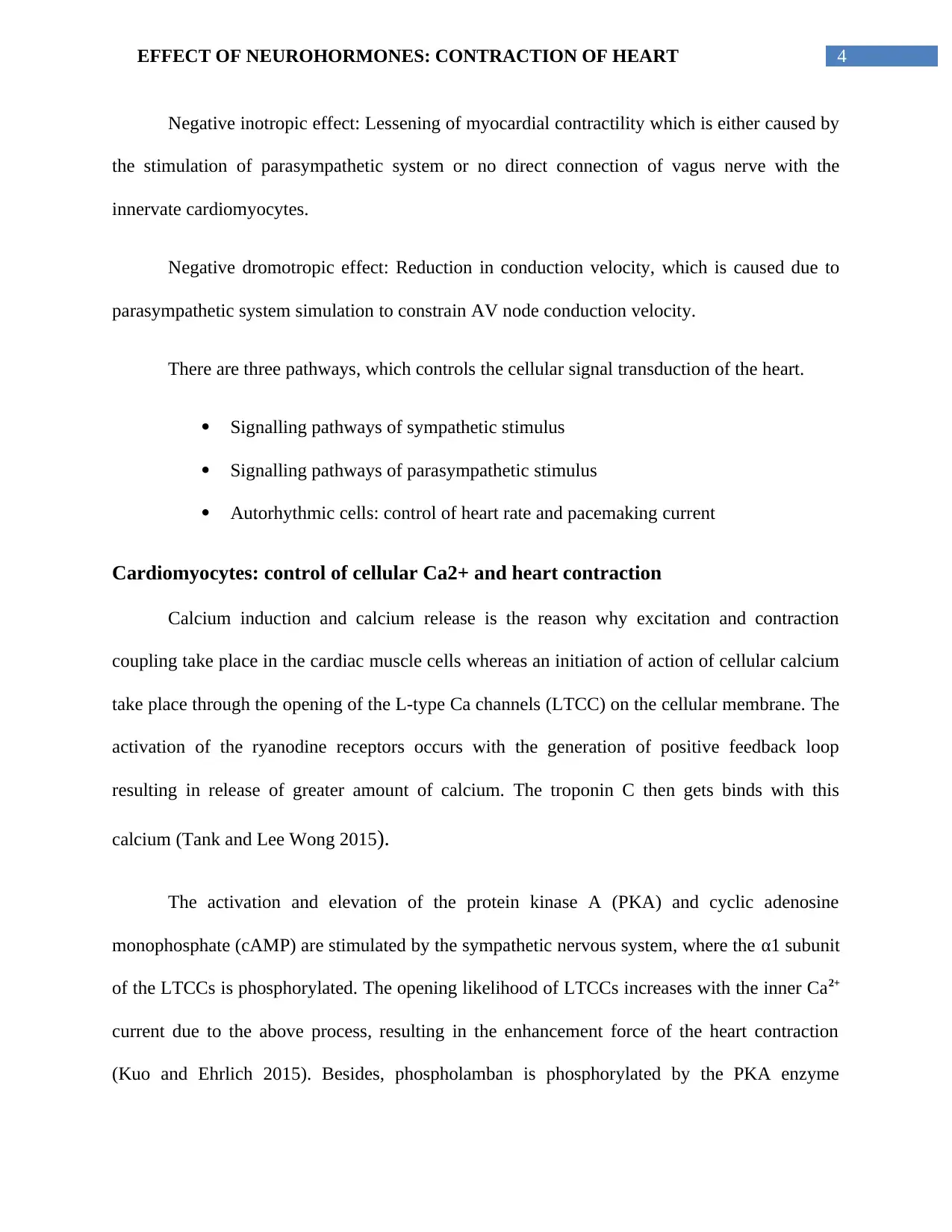
4EFFECT OF NEUROHORMONES: CONTRACTION OF HEART
Negative inotropic effect: Lessening of myocardial contractility which is either caused by
the stimulation of parasympathetic system or no direct connection of vagus nerve with the
innervate cardiomyocytes.
Negative dromotropic effect: Reduction in conduction velocity, which is caused due to
parasympathetic system simulation to constrain AV node conduction velocity.
There are three pathways, which controls the cellular signal transduction of the heart.
Signalling pathways of sympathetic stimulus
Signalling pathways of parasympathetic stimulus
Autorhythmic cells: control of heart rate and pacemaking current
Cardiomyocytes: control of cellular Ca2+ and heart contraction
Calcium induction and calcium release is the reason why excitation and contraction
coupling take place in the cardiac muscle cells whereas an initiation of action of cellular calcium
take place through the opening of the L-type Ca channels (LTCC) on the cellular membrane. The
activation of the ryanodine receptors occurs with the generation of positive feedback loop
resulting in release of greater amount of calcium. The troponin C then gets binds with this
calcium (Tank and Lee Wong 2015).
The activation and elevation of the protein kinase A (PKA) and cyclic adenosine
monophosphate (cAMP) are stimulated by the sympathetic nervous system, where the α1 subunit
of the LTCCs is phosphorylated. The opening likelihood of LTCCs increases with the inner Ca2+
current due to the above process, resulting in the enhancement force of the heart contraction
(Kuo and Ehrlich 2015). Besides, phospholamban is phosphorylated by the PKA enzyme
Negative inotropic effect: Lessening of myocardial contractility which is either caused by
the stimulation of parasympathetic system or no direct connection of vagus nerve with the
innervate cardiomyocytes.
Negative dromotropic effect: Reduction in conduction velocity, which is caused due to
parasympathetic system simulation to constrain AV node conduction velocity.
There are three pathways, which controls the cellular signal transduction of the heart.
Signalling pathways of sympathetic stimulus
Signalling pathways of parasympathetic stimulus
Autorhythmic cells: control of heart rate and pacemaking current
Cardiomyocytes: control of cellular Ca2+ and heart contraction
Calcium induction and calcium release is the reason why excitation and contraction
coupling take place in the cardiac muscle cells whereas an initiation of action of cellular calcium
take place through the opening of the L-type Ca channels (LTCC) on the cellular membrane. The
activation of the ryanodine receptors occurs with the generation of positive feedback loop
resulting in release of greater amount of calcium. The troponin C then gets binds with this
calcium (Tank and Lee Wong 2015).
The activation and elevation of the protein kinase A (PKA) and cyclic adenosine
monophosphate (cAMP) are stimulated by the sympathetic nervous system, where the α1 subunit
of the LTCCs is phosphorylated. The opening likelihood of LTCCs increases with the inner Ca2+
current due to the above process, resulting in the enhancement force of the heart contraction
(Kuo and Ehrlich 2015). Besides, phospholamban is phosphorylated by the PKA enzyme
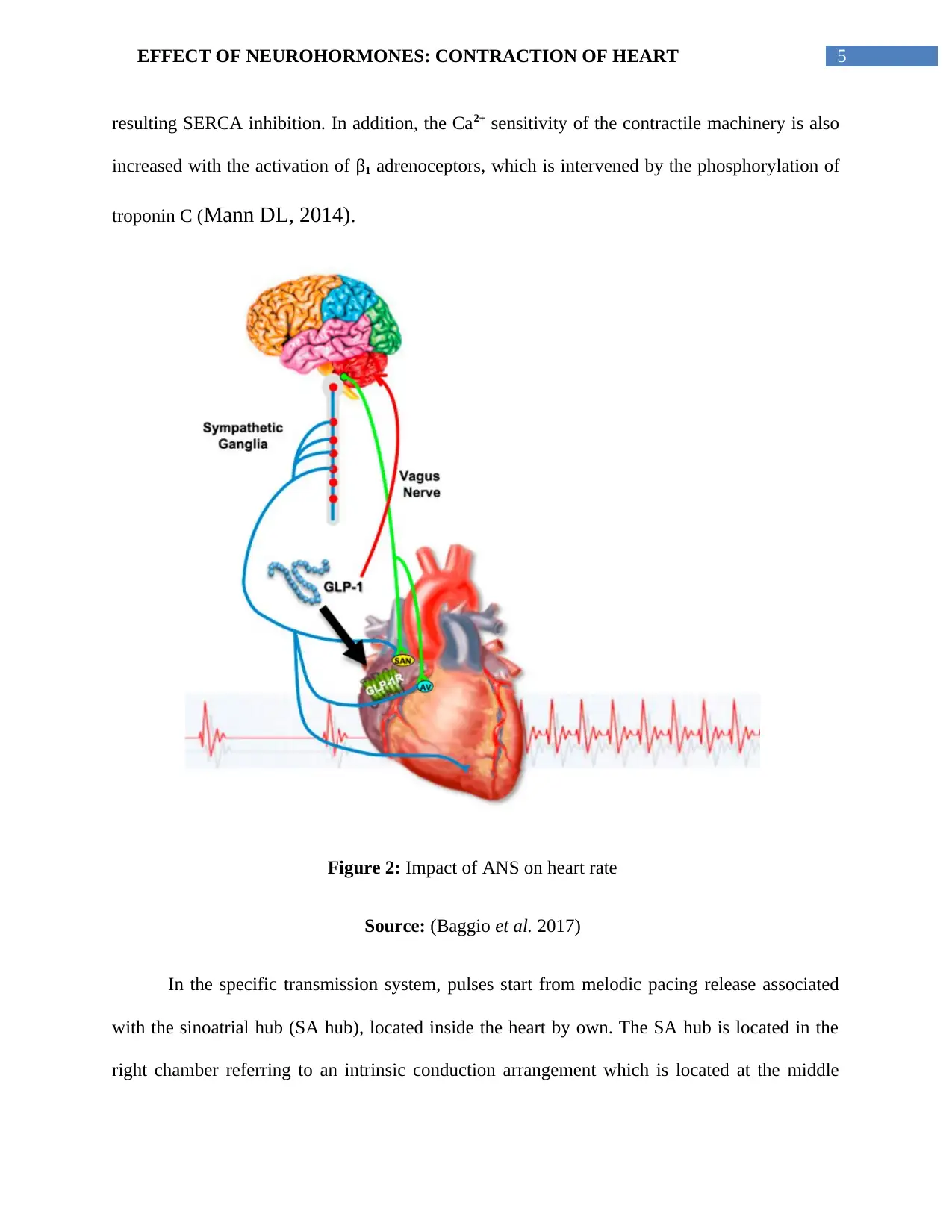
5EFFECT OF NEUROHORMONES: CONTRACTION OF HEART
resulting SERCA inhibition. In addition, the Ca2+ sensitivity of the contractile machinery is also
increased with the activation of β1 adrenoceptors, which is intervened by the phosphorylation of
troponin C (Mann DL, 2014).
Figure 2: Impact of ANS on heart rate
Source: (Baggio et al. 2017)
In the specific transmission system, pulses start from melodic pacing release associated
with the sinoatrial hub (SA hub), located inside the heart by own. The SA hub is located in the
right chamber referring to an intrinsic conduction arrangement which is located at the middle
resulting SERCA inhibition. In addition, the Ca2+ sensitivity of the contractile machinery is also
increased with the activation of β1 adrenoceptors, which is intervened by the phosphorylation of
troponin C (Mann DL, 2014).
Figure 2: Impact of ANS on heart rate
Source: (Baggio et al. 2017)
In the specific transmission system, pulses start from melodic pacing release associated
with the sinoatrial hub (SA hub), located inside the heart by own. The SA hub is located in the
right chamber referring to an intrinsic conduction arrangement which is located at the middle
⊘ This is a preview!⊘
Do you want full access?
Subscribe today to unlock all pages.

Trusted by 1+ million students worldwide
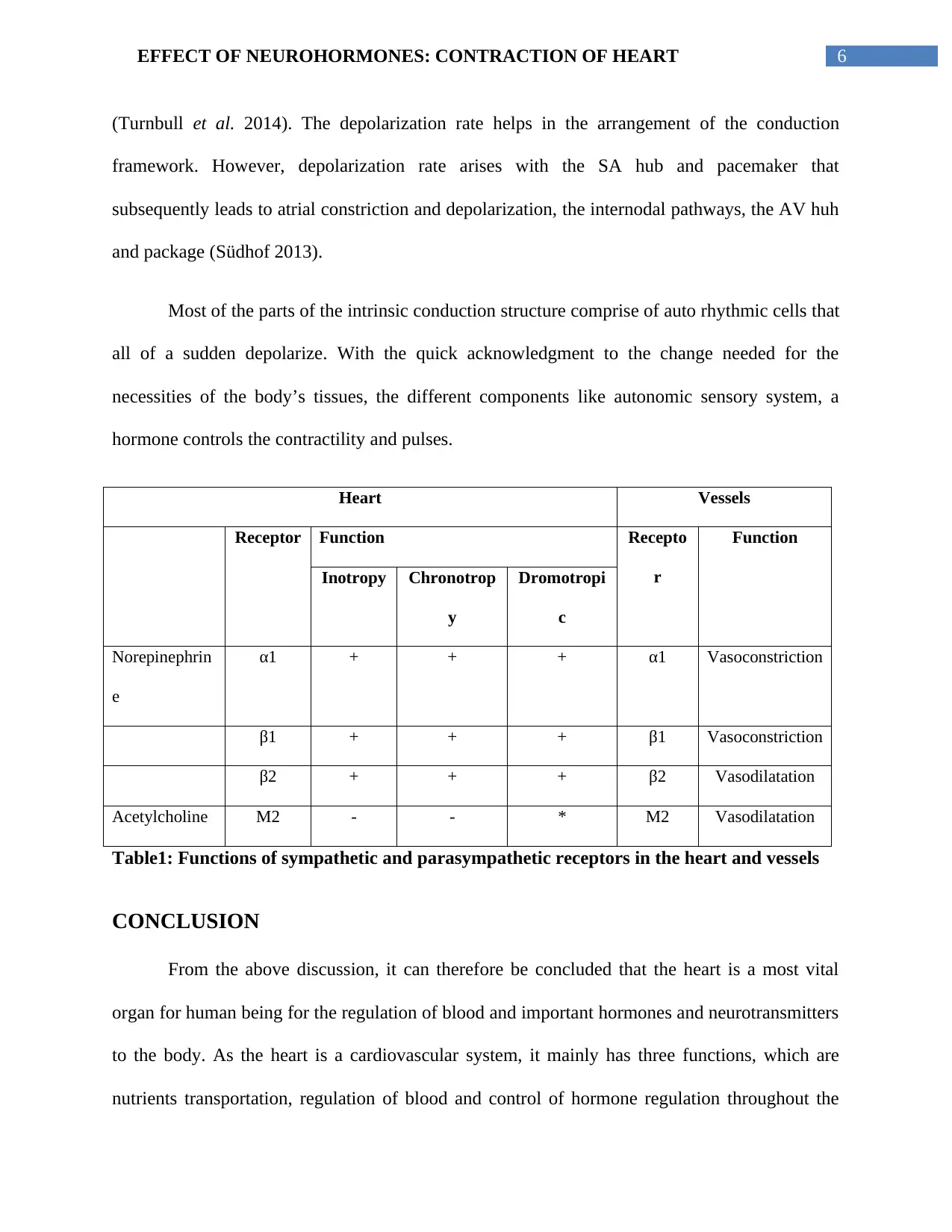
6EFFECT OF NEUROHORMONES: CONTRACTION OF HEART
(Turnbull et al. 2014). The depolarization rate helps in the arrangement of the conduction
framework. However, depolarization rate arises with the SA hub and pacemaker that
subsequently leads to atrial constriction and depolarization, the internodal pathways, the AV huh
and package (Südhof 2013).
Most of the parts of the intrinsic conduction structure comprise of auto rhythmic cells that
all of a sudden depolarize. With the quick acknowledgment to the change needed for the
necessities of the body’s tissues, the different components like autonomic sensory system, a
hormone controls the contractility and pulses.
Heart Vessels
Receptor Function Recepto
r
Function
Inotropy Chronotrop
y
Dromotropi
c
Norepinephrin
e
α1 + + + α1 Vasoconstriction
β1 + + + β1 Vasoconstriction
β2 + + + β2 Vasodilatation
Acetylcholine M2 - - * M2 Vasodilatation
Table1: Functions of sympathetic and parasympathetic receptors in the heart and vessels
CONCLUSION
From the above discussion, it can therefore be concluded that the heart is a most vital
organ for human being for the regulation of blood and important hormones and neurotransmitters
to the body. As the heart is a cardiovascular system, it mainly has three functions, which are
nutrients transportation, regulation of blood and control of hormone regulation throughout the
(Turnbull et al. 2014). The depolarization rate helps in the arrangement of the conduction
framework. However, depolarization rate arises with the SA hub and pacemaker that
subsequently leads to atrial constriction and depolarization, the internodal pathways, the AV huh
and package (Südhof 2013).
Most of the parts of the intrinsic conduction structure comprise of auto rhythmic cells that
all of a sudden depolarize. With the quick acknowledgment to the change needed for the
necessities of the body’s tissues, the different components like autonomic sensory system, a
hormone controls the contractility and pulses.
Heart Vessels
Receptor Function Recepto
r
Function
Inotropy Chronotrop
y
Dromotropi
c
Norepinephrin
e
α1 + + + α1 Vasoconstriction
β1 + + + β1 Vasoconstriction
β2 + + + β2 Vasodilatation
Acetylcholine M2 - - * M2 Vasodilatation
Table1: Functions of sympathetic and parasympathetic receptors in the heart and vessels
CONCLUSION
From the above discussion, it can therefore be concluded that the heart is a most vital
organ for human being for the regulation of blood and important hormones and neurotransmitters
to the body. As the heart is a cardiovascular system, it mainly has three functions, which are
nutrients transportation, regulation of blood and control of hormone regulation throughout the
Paraphrase This Document
Need a fresh take? Get an instant paraphrase of this document with our AI Paraphraser
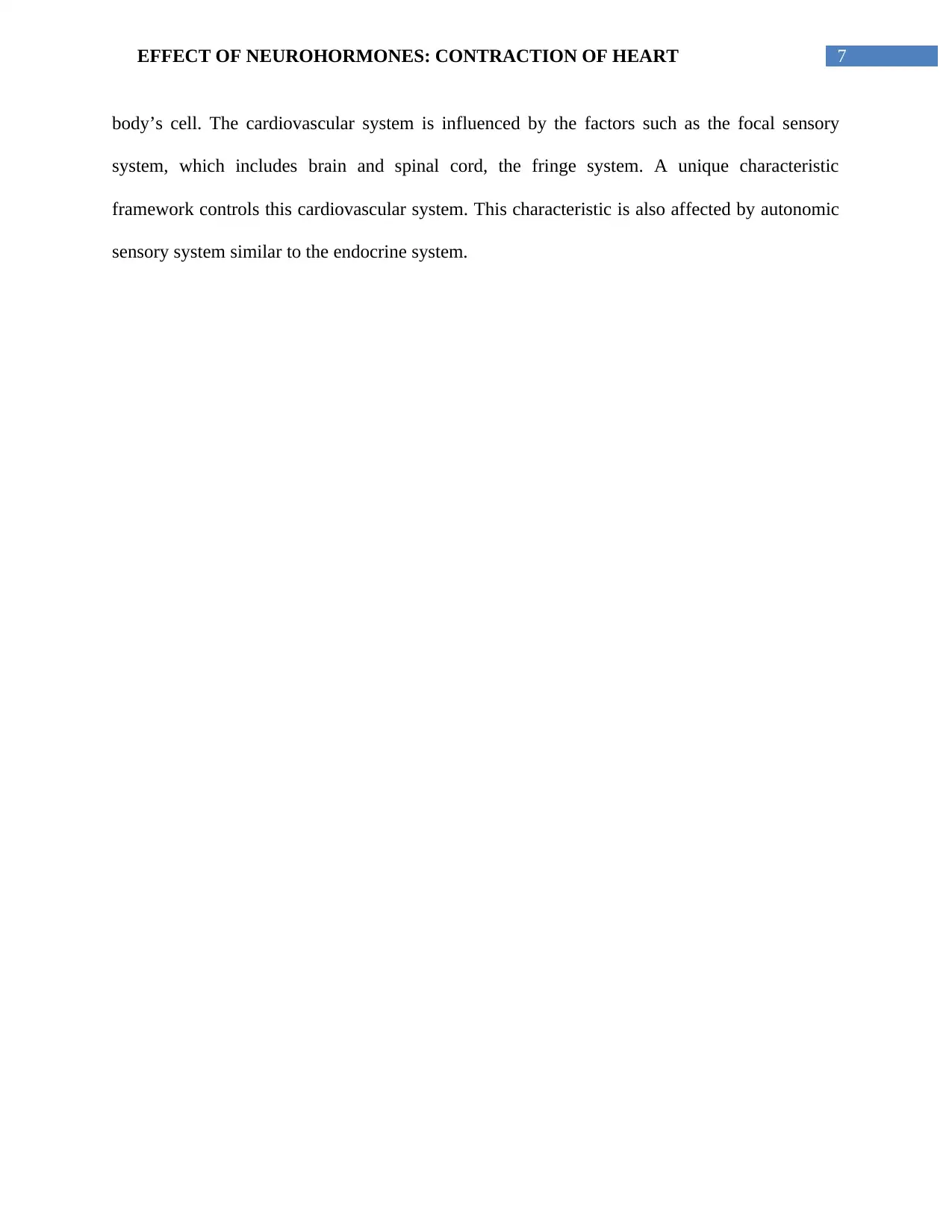
7EFFECT OF NEUROHORMONES: CONTRACTION OF HEART
body’s cell. The cardiovascular system is influenced by the factors such as the focal sensory
system, which includes brain and spinal cord, the fringe system. A unique characteristic
framework controls this cardiovascular system. This characteristic is also affected by autonomic
sensory system similar to the endocrine system.
body’s cell. The cardiovascular system is influenced by the factors such as the focal sensory
system, which includes brain and spinal cord, the fringe system. A unique characteristic
framework controls this cardiovascular system. This characteristic is also affected by autonomic
sensory system similar to the endocrine system.
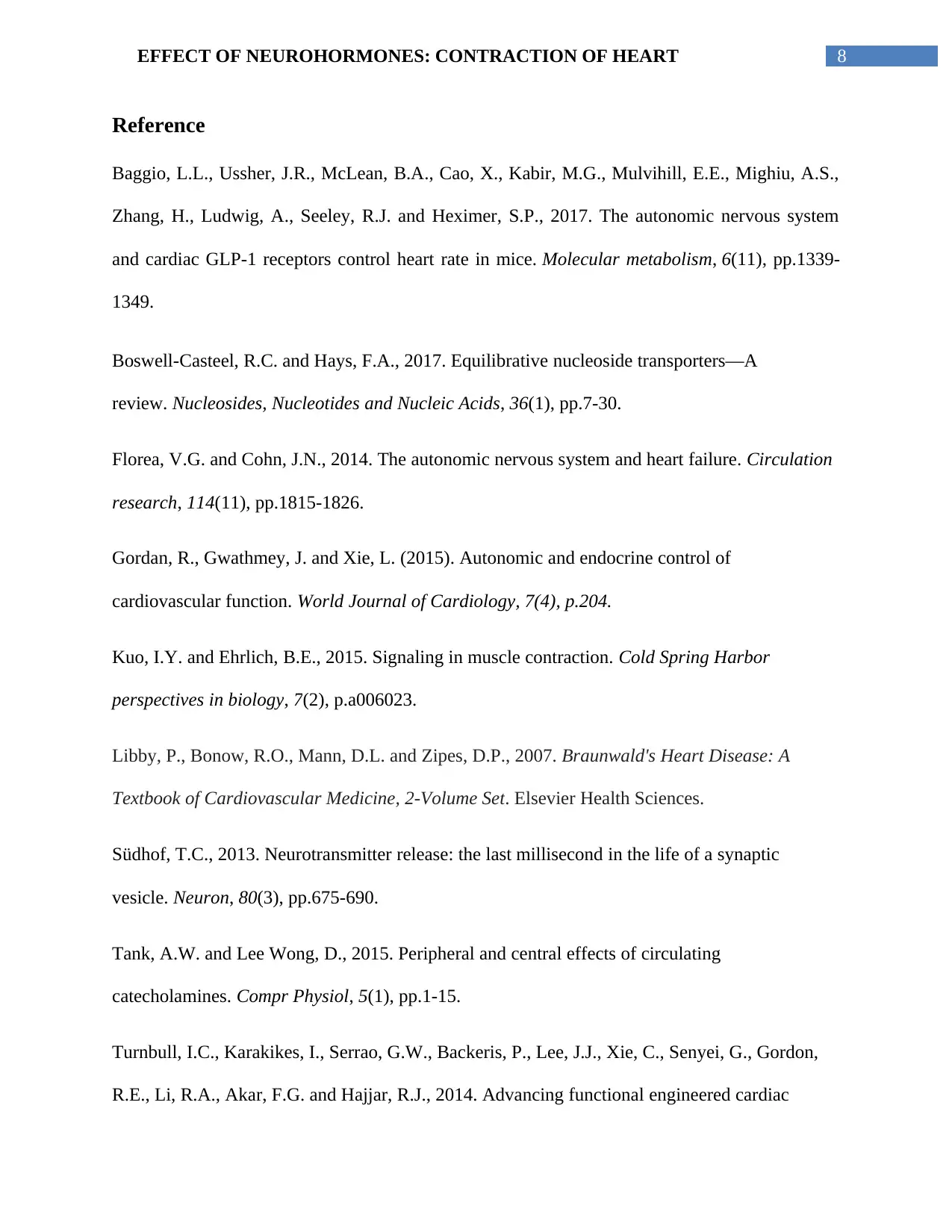
8EFFECT OF NEUROHORMONES: CONTRACTION OF HEART
Reference
Baggio, L.L., Ussher, J.R., McLean, B.A., Cao, X., Kabir, M.G., Mulvihill, E.E., Mighiu, A.S.,
Zhang, H., Ludwig, A., Seeley, R.J. and Heximer, S.P., 2017. The autonomic nervous system
and cardiac GLP-1 receptors control heart rate in mice. Molecular metabolism, 6(11), pp.1339-
1349.
Boswell-Casteel, R.C. and Hays, F.A., 2017. Equilibrative nucleoside transporters—A
review. Nucleosides, Nucleotides and Nucleic Acids, 36(1), pp.7-30.
Florea, V.G. and Cohn, J.N., 2014. The autonomic nervous system and heart failure. Circulation
research, 114(11), pp.1815-1826.
Gordan, R., Gwathmey, J. and Xie, L. (2015). Autonomic and endocrine control of
cardiovascular function. World Journal of Cardiology, 7(4), p.204.
Kuo, I.Y. and Ehrlich, B.E., 2015. Signaling in muscle contraction. Cold Spring Harbor
perspectives in biology, 7(2), p.a006023.
Libby, P., Bonow, R.O., Mann, D.L. and Zipes, D.P., 2007. Braunwald's Heart Disease: A
Textbook of Cardiovascular Medicine, 2-Volume Set. Elsevier Health Sciences.
Südhof, T.C., 2013. Neurotransmitter release: the last millisecond in the life of a synaptic
vesicle. Neuron, 80(3), pp.675-690.
Tank, A.W. and Lee Wong, D., 2015. Peripheral and central effects of circulating
catecholamines. Compr Physiol, 5(1), pp.1-15.
Turnbull, I.C., Karakikes, I., Serrao, G.W., Backeris, P., Lee, J.J., Xie, C., Senyei, G., Gordon,
R.E., Li, R.A., Akar, F.G. and Hajjar, R.J., 2014. Advancing functional engineered cardiac
Reference
Baggio, L.L., Ussher, J.R., McLean, B.A., Cao, X., Kabir, M.G., Mulvihill, E.E., Mighiu, A.S.,
Zhang, H., Ludwig, A., Seeley, R.J. and Heximer, S.P., 2017. The autonomic nervous system
and cardiac GLP-1 receptors control heart rate in mice. Molecular metabolism, 6(11), pp.1339-
1349.
Boswell-Casteel, R.C. and Hays, F.A., 2017. Equilibrative nucleoside transporters—A
review. Nucleosides, Nucleotides and Nucleic Acids, 36(1), pp.7-30.
Florea, V.G. and Cohn, J.N., 2014. The autonomic nervous system and heart failure. Circulation
research, 114(11), pp.1815-1826.
Gordan, R., Gwathmey, J. and Xie, L. (2015). Autonomic and endocrine control of
cardiovascular function. World Journal of Cardiology, 7(4), p.204.
Kuo, I.Y. and Ehrlich, B.E., 2015. Signaling in muscle contraction. Cold Spring Harbor
perspectives in biology, 7(2), p.a006023.
Libby, P., Bonow, R.O., Mann, D.L. and Zipes, D.P., 2007. Braunwald's Heart Disease: A
Textbook of Cardiovascular Medicine, 2-Volume Set. Elsevier Health Sciences.
Südhof, T.C., 2013. Neurotransmitter release: the last millisecond in the life of a synaptic
vesicle. Neuron, 80(3), pp.675-690.
Tank, A.W. and Lee Wong, D., 2015. Peripheral and central effects of circulating
catecholamines. Compr Physiol, 5(1), pp.1-15.
Turnbull, I.C., Karakikes, I., Serrao, G.W., Backeris, P., Lee, J.J., Xie, C., Senyei, G., Gordon,
R.E., Li, R.A., Akar, F.G. and Hajjar, R.J., 2014. Advancing functional engineered cardiac
⊘ This is a preview!⊘
Do you want full access?
Subscribe today to unlock all pages.

Trusted by 1+ million students worldwide
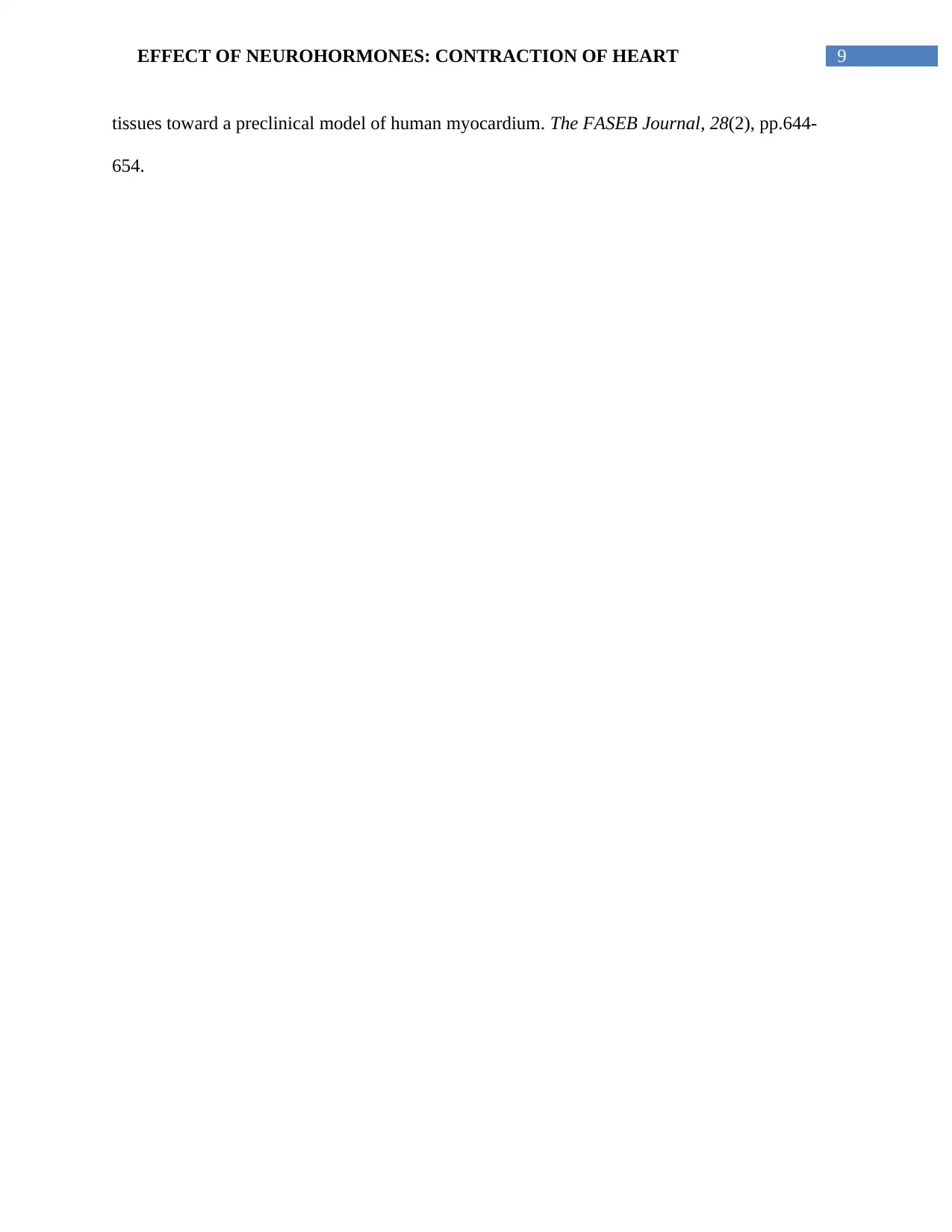
9EFFECT OF NEUROHORMONES: CONTRACTION OF HEART
tissues toward a preclinical model of human myocardium. The FASEB Journal, 28(2), pp.644-
654.
tissues toward a preclinical model of human myocardium. The FASEB Journal, 28(2), pp.644-
654.
1 out of 10
Related Documents
Your All-in-One AI-Powered Toolkit for Academic Success.
+13062052269
info@desklib.com
Available 24*7 on WhatsApp / Email
![[object Object]](/_next/static/media/star-bottom.7253800d.svg)
Unlock your academic potential
Copyright © 2020–2025 A2Z Services. All Rights Reserved. Developed and managed by ZUCOL.



